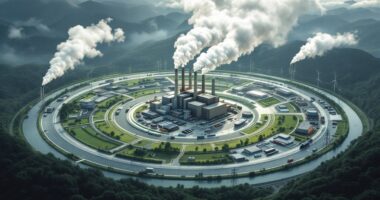Environmental risk assessment serves as nature’s security system, systematically identifying potential threats before they harm ecosystems. The process involves hazard identification, exposure assessment, toxicity evaluation, risk characterization, and management strategies. Methods range from biomonitoring and GIS mapping to fate-and-transport models and community involvement. These assessments inform critical decisions about pesticides, GMOs, and development near sensitive areas like wetlands. Despite challenges from chemical interactions and climate change, innovations in AI and citizen science are expanding our capacity to protect environmental health.

While our world becomes increasingly industrialized and developed, environmental risk assessment has emerged as a critical tool for safeguarding our planet’s health. Like detectives solving eco-mysteries, environmental scientists work through a systematic process to identify potential threats lurking in our air, water, and soil before they can wreak havoc on delicate ecosystems.
The assessment process unfolds like a well-rehearsed play in five acts: hazard identification (spotting the villains), exposure assessment (figuring out who might encounter them), toxicity assessment (determining just how nasty they are), risk characterization (calculating the odds of trouble), and finally, risk management (devising clever ways to avoid disaster).
It’s fundamentally nature’s version of a home security system—identify threats, assess vulnerability, and implement safeguards. ISO 14001 certification requires organizations to conduct thorough risk assessments for environmental aspects throughout their operations. Before any major project begins, proper impact assessments are required to evaluate potential environmental consequences and inform decision-making processes.
Scientists don’t just rely on hunches; they employ an impressive arsenal of methods. They might conduct biomonitoring—fundamentally asking fish and wildlife to serve as unwitting chemical detectives by measuring contaminant levels in their tissues. Comprehensive case studies from water bodies like Long Creek, ME demonstrate the complexity of urban systems when assessing multiple potential stressors on aquatic ecosystems.
Nature’s silent sentinels—creatures unwittingly serving as living laboratories, their bodies telling chemical tales our instruments might miss.
GIS mapping allows experts to visualize risk patterns across landscapes (think Google Maps but for pollution hotspots), while fate-and-transport models predict how contaminants might travel through environments like party gossip through a small town.
These assessments aren’t just academic exercises. They determine whether that new pesticide ends up on farm fields or stays in the laboratory, whether GMO crops get planted, and how close housing developments can snuggle up to wetlands.
They’re the scientific backbone of environmental protection worldwide.
Of course, challenges abound. Try predicting how thousands of chemicals might interact in a pond ecosystem—it’s like forecasting all possible conversations at a cocktail party.
And climate change? That’s rewriting all the rules mid-game.
Fortunately, innovation continues. Modern assessments increasingly incorporate ecosystem services valuation (putting price tags on nature’s benefits), while AI and machine learning help process mountains of environmental data.
Citizen scientists are joining the ranks too, turning environmental detective work into a community effort.
Frequently Asked Questions
How Do Economic Factors Influence Environmental Risk Assessment Priorities?
Economic factors profoundly shape environmental risk assessment priorities through multiple channels. Wealthy nations typically dedicate more resources to environmental protection, while developing economies often prioritize growth over ecological concerns. Market-based instruments like carbon pricing directly influence corporate risk strategies.
During economic downturns, environmental budgets frequently face cuts. Different economic sectors also drive specific assessment focuses—energy shifts guide climate risk evaluations, while agricultural concerns shape food security assessments.
Can Indigenous Knowledge Improve Identification of Environmental Hazards?
Indigenous knowledge can substantially enhance environmental hazard identification. Drawing from generations of ecological observations, indigenous communities often detect subtle environmental changes before they register in conventional monitoring systems.
Their holistic understanding of ecosystem relationships provides early warning signals for potential disasters. While scientific methods measure specific parameters, indigenous knowledge offers contextual interpretation based on centuries of land stewardship. When these knowledge systems collaborate rather than compete, communities gain more thorough hazard identification capabilities that blend precise measurements with nuanced ecological understanding.
How Are Multiple Interacting Eco-Hazards Assessed Simultaneously?
Multiple interacting eco-hazards are assessed through several complementary approaches. Researchers employ multi-layer mapping to identify spatial overlaps, while composite frequency indices quantify combined impacts.
Modern assessment frameworks classify hazard relationships as independent, mutex, parallel, or series. Probabilistic methods help determine correlations between events, while compound and cascading risk analyses track how hazards trigger or amplify each other. This thorough approach has replaced outdated single-hazard assessments that missed critical interactions between environmental threats.
What Digital Tools Best Support Real-Time Environmental Risk Monitoring?
Real-time environmental risk monitoring thrives on integrated digital ecosystems. IoT sensor networks capture continuous data streams while cloud platforms aggregate this information into actionable insights.
Satellite imaging and drone technology extend monitoring reach to remote areas. AI algorithms detect anomalies and predict emerging threats before they escalate. Mobile apps deliver instant alerts to stakeholders, while automated reporting tools guarantee regulatory compliance. These technologies form a digital nervous system that transforms environmental vigilance from reactive to proactive.
How Does Climate Change Uncertainty Affect Long-Term Risk Assessment Models?
Climate change uncertainty complicates long-term risk assessment models like a weather forecast extending decades instead of days. As time horizons stretch beyond 30 years, models struggle with “Minsky moment” tipping points and complex climate-economy interactions.
Effective strategies include employing multiple model types, incorporating both physical and evolutionary risks, and using scenario analysis to account for various futures. The uncertainty isn’t just a limitation—when properly acknowledged, it actually enhances assessment quality by highlighting knowledge gaps requiring attention.









